The Red-bellied Woodpecker (Melanerpes carolinus) adds a certain charm to the deciduous and mixed forests of the eastern United States with its zebra-patterned upperside and red head.
Interestingly enough, the faint red wash on its stomach is its least noticeable characteristic. Next time you hear a woodpecker drumming, keep your eyes peeled and see whether it might be this energetic guy!
On this page
Breeding Male
Male Red-bellied Woodpeckers have black-and-white barred wings, tails, and backs. Their face, throat, and bellies are pale, and their crown and nape are red. The reddish shade on their underside can be quite difficult to spot. On average, males are 8-9% bigger than females.
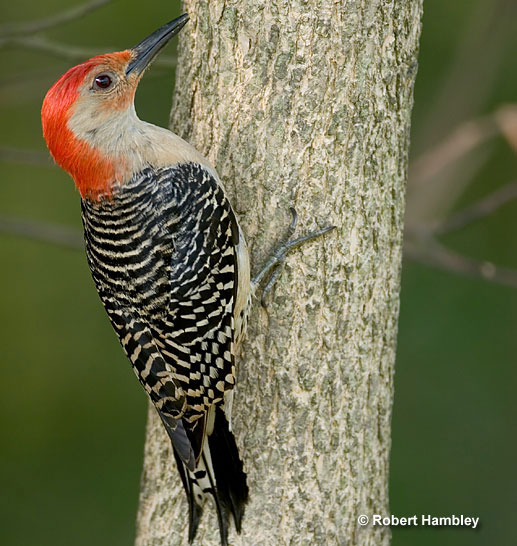
Female
Female Red-bellied Woodpeckers are quite similar to males. They also sport a bold black-and-white barring on their upperside, a pale belly, throat, and face, and a red nape.
However, their crown is gray instead of red. Females are generally smaller than males.
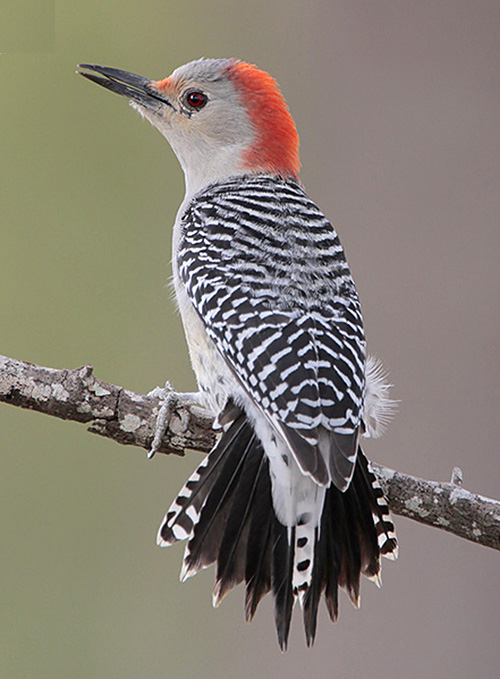
Female. Photograph © Greg Lavaty.
Juvenile
Depending on their location, Red-bellied Woodpeckers can have 1-3 broods in a year. The birds in northern areas have one and birds in the southern range may have two to three broods.
The female lays 3-8, usually 4-5 white eggs in a clutch. Both parents take part in the 12-14-day incubation process with the male incubating at night. After hatching, the nestlings are fed by both parents and are ready to leave the nest after about 22-27 days.
The birds reach independence around 6-10 weeks after leaving the nest, at which point the parents won’t take care of them anymore and chase them away.
Juvenile Red-bellied Woodpeckers look similar to adults, but they lack vibrant red crowns and napes, although they might have a slight reddish hue to them. They also have horn-colored bills instead of black ones.
Red-bellied Woodpeckers grow to be about 9-10 inches long and weigh 2-3.2 ounces.
Habitat
Red-bellied Woodpeckers most commonly choose to inhabit deciduous forests, especially those along rivers and in swamps. You can also find them in forests that have both coniferous and deciduous trees, in more open areas such as clearings, forest edges, groves, orchards, and shade trees in suburbs.
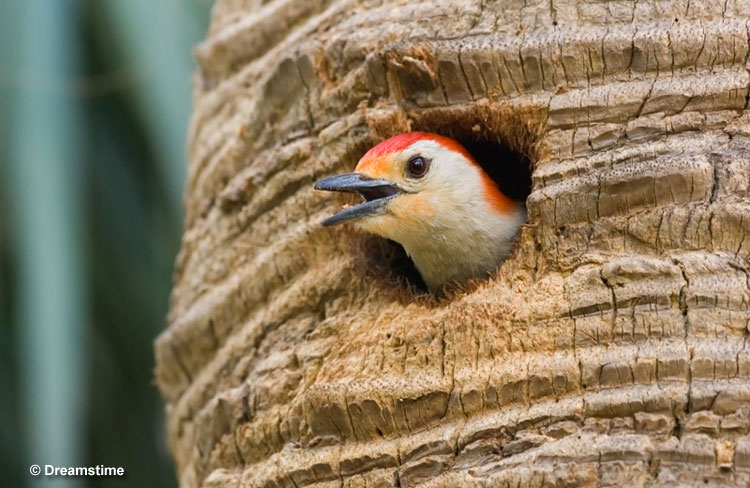
Red-bellied Woodpeckers nest in cavities they excavate themselves into dead wood, such as dead trees or dead limbs of living trees, tree stumps, or even fence posts. They may also use natural cavities, abandoned cavity nests, or nest boxes. They won’t bring any other materials into the nest and the only lining it has are left-over wood chips from excavation.
Diet
Red-bellied Woodpeckers eat both animal and plant matter. The animal part of their diet includes mostly invertebrates, such as insects, ants, grasshoppers, larvae, caterpillars, and flies. They may also eat small nestlings and eggs, small amphibians such as frogs, small reptiles, and small fish such as minnows. The plant part of their diet includes seeds and grains, nuts, fruit, and sap.
These woodpeckers have many methods to acquire food. Their primary foraging method is to chisel into tree bark or probe the cracks on tree trunks with their long and sticky tongue to catch insects.
Males tend to forage on tree trunks whereas females search for food higher on tree limbs. They also fly out to catch insects mid-air. You can see them climbing and perching on branches to snack on berries, fruits, and nuts.
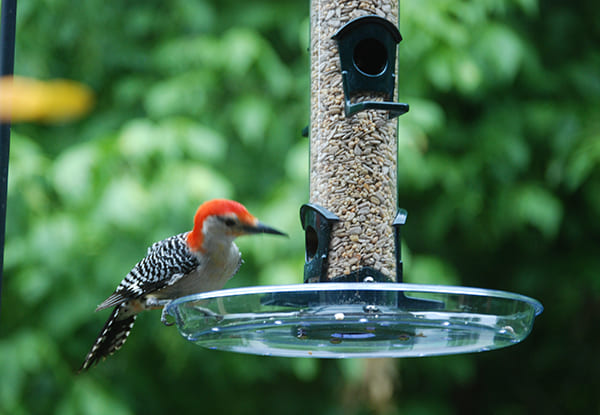
Red-bellied Woodpeckers also come to feeders.
Once they’ve caught their food, then smaller pieces are swallowed whole whereas larger prey is smacked against the tree and eaten in pieces. They store nuts and seeds in bark crevices to eat during winter.
Behavior
Red-bellied Woodpeckers are solitary birds active during the daytime. They are year-round residents throughout their range and, as such, defend their territory year-round. The birds of the same gender may have conflicts resulting in chases and mid-air collisions. However, they’ve also been observed to exhibit playful behavior.
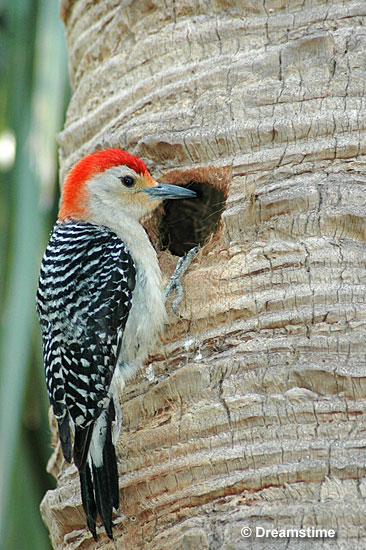
During the breeding season, they form monogamous pair bonds and defend their nest and offspring very aggressively. They may even attack approaching predators. Outside the breeding season, however, they harass intruders only with alarm calls or hide from them altogether.
Range (and seasonal changes)
Red-bellied Woodpeckers range throughout the eastern United States from Florida as far north as southernmost Canada. They are year-round residents and only move to find better food supplies.
Related: Types of Woodpeckers in North America
These birds are listed as of least concern on the IUCN Red List, and their population seems to be growing. They are an adaptable species capable of inhabiting a variety of forests and even suburban areas.
Wing shape
Red-bellied Woodpeckers have a wingspan of 13-16.5 inches. Their wings are short and broad, which doesn’t help the bird reach high speeds. However, these kinds of wings are perfect for flying in forests because they offer great maneuverability at low speeds and the ability to take off and accelerate quickly.
You can recognize a Red-bellied Woodpecker in flight by its undulating flight pattern and flashing white patches near its wingtips.
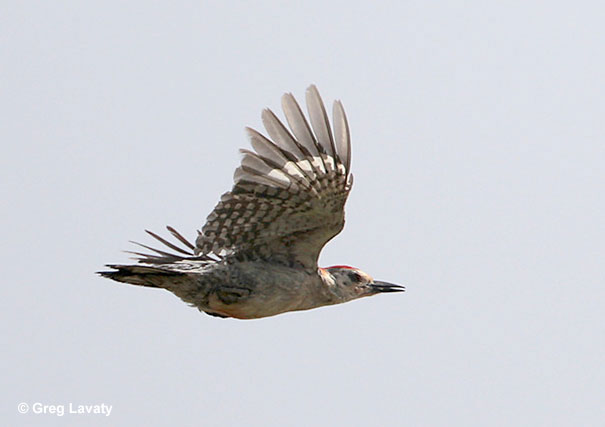
Fun Facts
- Red-bellied Woodpeckers have an interesting feeding adaptation. Their tongue is sticky and long, reaching about 2 inches past the tip of its beak, and has a barbed tip. The tongues of males and females are slightly different, which also carries over to their feeding behavior – males forage lower on tree trunks, whereas females generally forage higher on larger tree limbs.
- Red-bellied Woodpeckers cache food for later use, usually for winter, by wedging seeds and nuts into crevices and small holes.
- Woodpeckers’ noses are covered in tiny feathers that help keep wood dust and debris out of their nose.
- Red-bellied Woodpeckers are made to cling to trees. They have two toes in the front and two in the back and strong tail feathers, which makes it easier for the bird to hold onto a tree trunk.
- Red-bellied Woodpeckers and woodpeckers overall have unique bills and skulls that allow them to dissipate and transfer energy directly into their bodies, with only about 0.3% of the stress applying to the brain.
Call
Red-bellied Woodpeckers have quite a few sounds and calls to communicate. Their most common call is a rolling and shrill thrraa-thrraa or churr-churr.
They may also growl when they’re close together, and mates give coughing cha-cha-cha sounds or chatter to communicate between long distances.
The birds also drum on dead trees to either communicate or establish ownership.
Similar Species
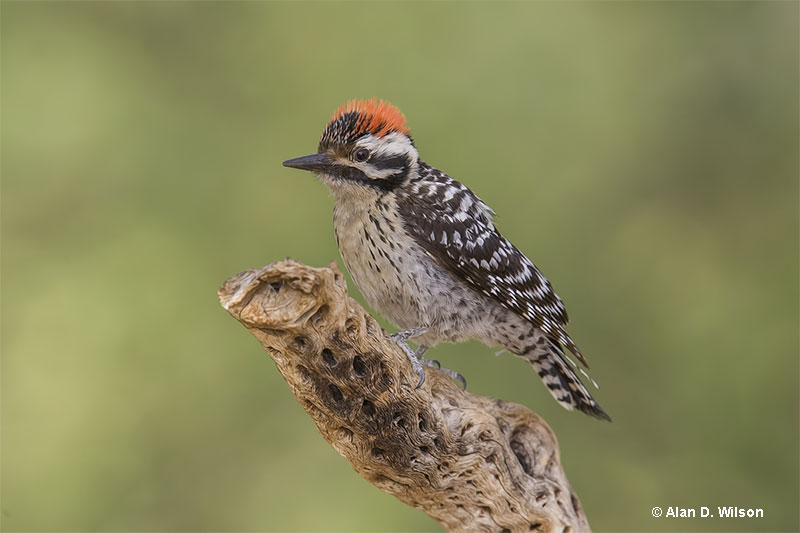
Ladder-backed Woodpecker
As their name hints, Ladder-backed Woodpeckers have a ladder-like pattern on their backs. Red-bellied Woodpeckers have a similar pattern, but their wings have a similar pattern.
While Latter-backed Woodpeckers have some black speckles on their chest, Red-bellied Woodpeckers have a white chest.
Red-bellied Woodpeckers are a bit bigger in size.
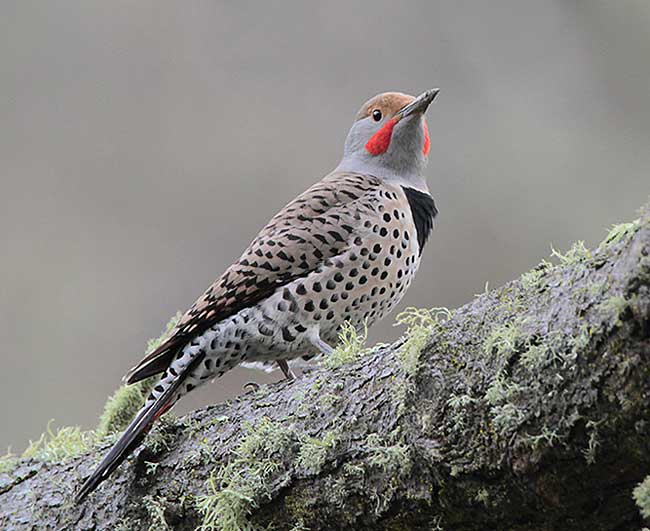
Northern Flicker
Compared to Red-Bellied Woodpeckers, Northern Flickers have more brown tones in their plumage.
They have overlapping ranges, but Northern Flickers can be seen over most of North America.
Northern Flickers can be seen around open woodlands.
Frequently Asked Questions
Why do they call it a Red-bellied Woodpecker?
Red-bellied Woodpeckers got their name from the light reddish or pinkish wash on their bellies. However, it can be quite difficult to spot.
How rare is a Red-bellied Woodpecker?
Red-bellied Woodpeckers are quite adaptable and fairly common across wooded areas in the eastern United States. You may also meet them in wooded suburbs.
What is the difference between a male and female Red-bellied Woodpecker?
Male Red-bellied Woodpeckers have a red crown whereas females have a gray crown. Males are also a bit larger on average.

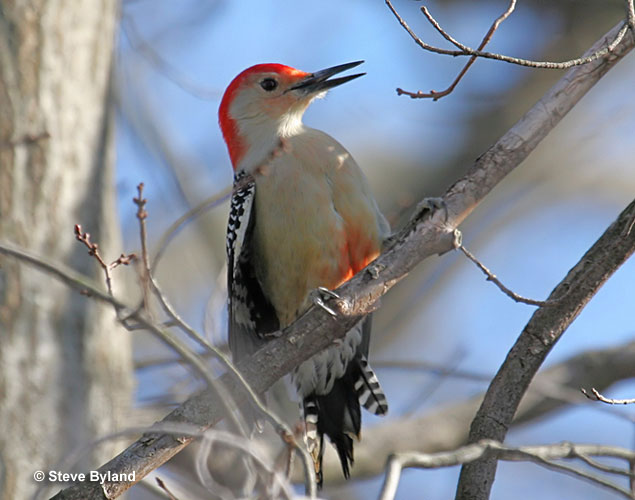
Alexa
Sunday 16th of April 2023
For the past 2 weeks a large Red Bellied Woodpecker chose my rain gutter to partake in a "pecker" measuring contest. Between the hours of 5am and 7am every morning it would use my house to pronounce its desires. Four days ago during the late afternoon I heard what could be described as a squeaky toy furiously making noise. In a tree branch was my morning friend and an interested mate. Squeak,squeak,squeak then heads pointed upwards, and done. While I have enjoyed the past 3 quiet mornings, I miss that fellow. Love is weird and wonderful.